
Shugendō Lavatories
Shugendō
Jump aheadto the fixtures!
Shugendō
is a syncretic religion that formed in Japan
during the period 710–794 CE,
after the Emperess Genmei had established a capital
at Heijō-kyō, today's Nara,
and before Emperor Kammu moved the Imperial Court to
Heian-kyō, today's Kyōto.
Shugendō combined elements
of the native Japanese Shintō,
esoteric Buddhism as it was arriving from China,
Taoism,
and local shamanistic folk religions.
A practitioner is called Yamabushi,
a "Mountain Prostrator".
Shugendō was suppressed after
the Meiji Restoration of 1868 in which the Emperor
took control of Japan away from the Shōgunate.
The relationship between the state and Shintō
was terminated with the end of World War II.
Freedom of religion was established,
and Shugendō returned to greater prominence.
Mount Haguro, east of Tsuruoka
on the edge of the central mountain range,
is a prominent site for Shugendō.
The Origins of Shugendō
Jump aheadto the fixtures!
The mystic En no Ozunu came to be known as En no Gyōja or "En the Ascetic". He was banished by the Imperial Court on 26 June 699 CE, to Izu Ōshima, a volcanic island 22 kilometers off the Izu Peninsula of Honshū. The historical chronicle Shoku Nihongi reported:
Ozunu had first lived in Mount Katsuragi and been acclaimed for his sorcery and was the teacher of Outer Junior 5th Rank Lower Grade Karakuni no Muraji Hirotari. Later, [a person, or Hirotari] envied his power and accused him of trickery with his weird magic. The Imperial Court banished him far from the Capital. Rumor says, "Ozunu was able to manipulate demonic spirits, making them draw water and gather firewood. When they disobeyed, he bound them using sorcery."
En no Gyōja organized the doctrine of Shugendō, which literally means "the path of training and testing" or "the way to spiritual power through discipline". He included beliefs, philosophies, and rituals from Shintō mountain worship, local shamanic practices, Taoism, and Buddhism.
Shugendō extended to the north and merged with a mountaintop religious tradition established here in Dewa province in 593 CE by the son of an assassinated Emperor.
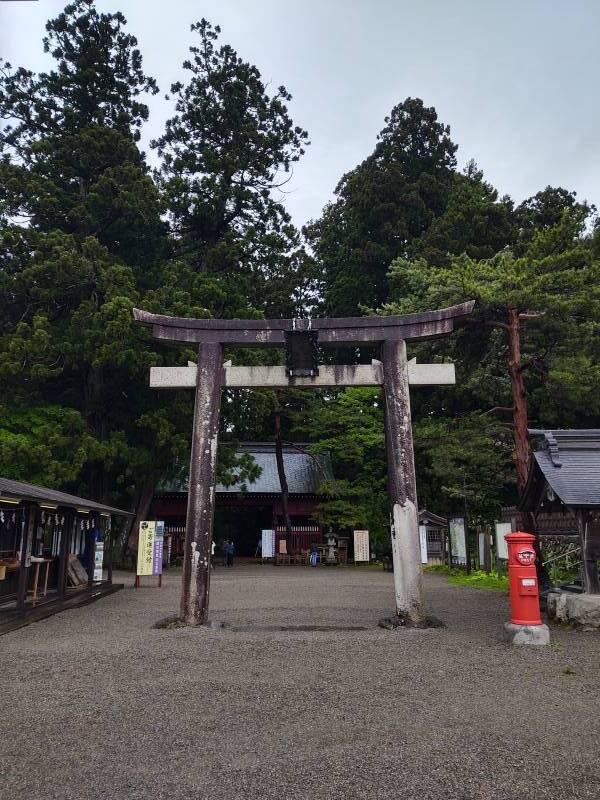
A large torii or Shintō gate at the lower end of the path up Mount Haguro.
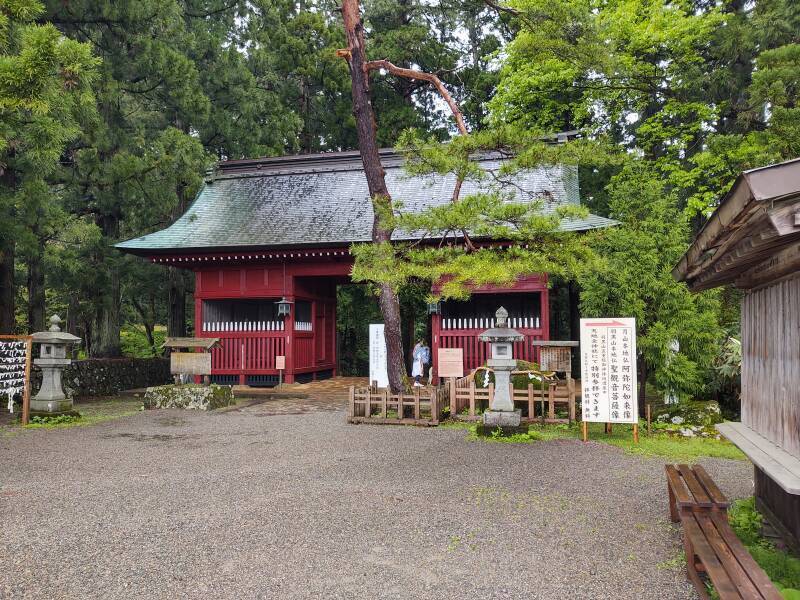
A Buddhist monk was blowing a conch shell as I arrived at the much more Buddhist style Zuishi-mon beyond the torii, mon meaning "gate". Until the Meiji Restoration this was known as the Niō-mon, honoring the Buddhist figure known to the Japanese as Niō and as Vajradhara in the original Sanskrit.
In "Religious Rituals in Shugendō — A Summary", Japanese Journal of Religious Studies, 1989 16/2–3, the religious scholar Miyake Hitoshi describes the Shugendō rituals as "festivals, fortunetelling, divination, prayers and incantations, exorcism, spells, charms and so forth", and the Shugendō worldview as one which:
[...] assumes the existence of at least two realms of existence, that of the daily lives of human beings, and a separate, supernatural spiritual realm behind, and which controls that of the daily lives of human beings. The mountains are seen either as a sacred space which is part of both of these worlds, or is seen to actually be a part of the spiritual world. The altar space during the fire ceremony, or the area of a matsuri, is also considered to be this kind of sacred space.
VisitingKōya-san
Early practitioners of Shugendō were said to be descendents of the Kōya Hijiri monks, the lower-caste monks of the temples at the Kōya-san temple complex south of Kyōto and Nara. This led to the incorporation of esoteric Buddhism, as Vajrayana Buddhism from China had arrived at Kōya-san to influence the Shingon sect founded there in 819 CE by Kūkai.
VisitingKyōto
During the Heian period of 794–1185, starting when Emperor Kammu moved the Imperial Court to Kyōto, Shugendō became popular among the nobles in Kyōto. They frequently visited three major shrines in the Kii mountains around Kōya-san. Those shrines were common holy places to Shugendō, Shintō, and Buddhism.
The most important Shugendō practices take place in the mountains. Sacred mountains are seen as supernatural homes of deities. The tantric Buddhist deity Fudō Myōō plays a central role. The Yamabushi or Shungenja, the practitioner, identifies with Fudō Myōō and gains the ability to use Fudō Myōō's powers through these mountain practices.
The practitioner may enter the mountains to offer flowers, or to read or bury sutras, the Buddhist holy writings. The practitioner may also undertake a mountain retreat for a certain period of time, undertaking various ascetic practices in the hopes of receiving esoteric knowledge. The most advanced of those is an ascetic retreat in the mountains during the winter.
Shugendō practitioners may also carry out ceremonies honoring kami, the Shintō deities or spirits. Over the centuries of Shugendō's evolution, Shintō and Buddhism became somewhat blended in a process called shinbutsu-shūgō, and Shugendō participated in that blending. Shintō kami were interpreted as manifestations of Buddhas. For example, these two small Shintō shrines near the beginning of the Mount Haguro path are accompanied by small statues of Buddhist deities and other Buddhist symbols.
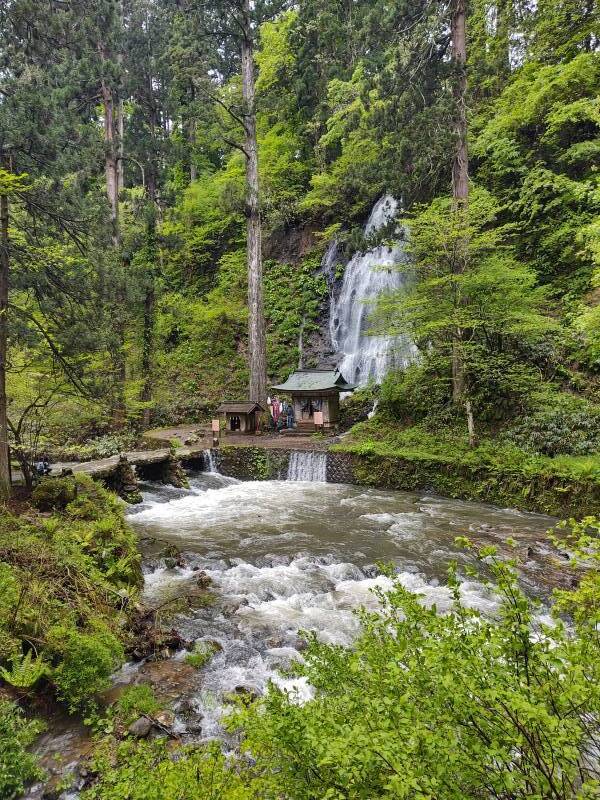
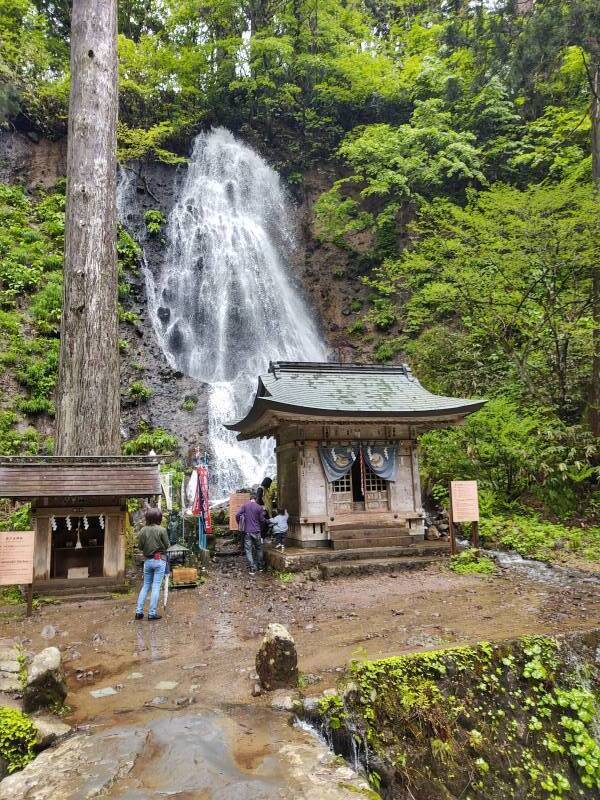
Gojū-no-tō, the five-level pagoda near the beginning of the trail, is a form of a Buddhist stupa or burial mound. A nearby sign explains that its date of construction is uncertain. Maybe the samurai Taira no Masakado built it during the Jōhei era of 931–938 CE. Or maybe it wasn't built until the first year of the Shōwa era, 1312 CE (making this an earlier Shōwa six centuries before Hirohito).
Its levels are approximately six meters high, for a total height of 29.2 meters. The ceiling of the first floor is lacquered black with gold and vermillion-color decoration. Only the first floor has windows constructed in the mekura-renji style, a form of "blind lattice". The other floors' windows have regular lattices. This style argues for an earlier construction, so maybe the samurai built it.
The widths of a pagoda's roofs usually shrink in inverse proportion to their height. On this pagoda, however, the fifth floor's roof is seventy percent as wide as the first floor's.
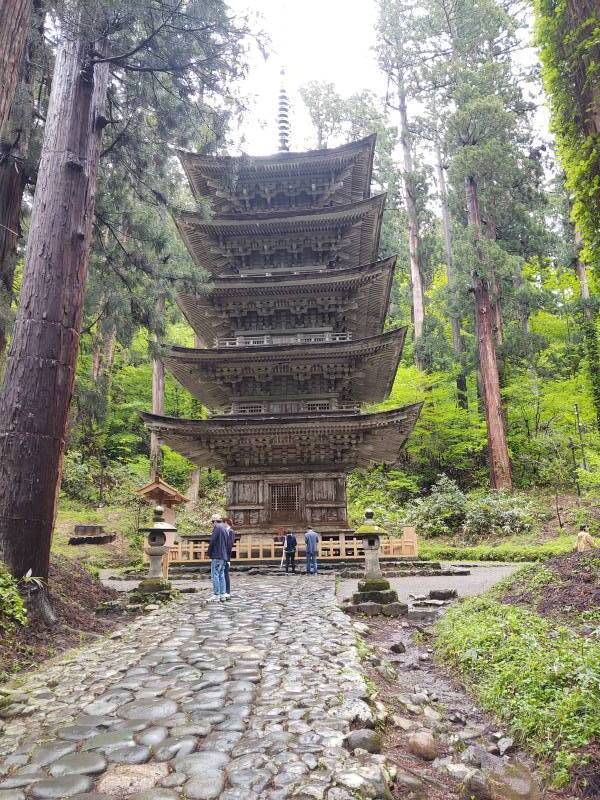
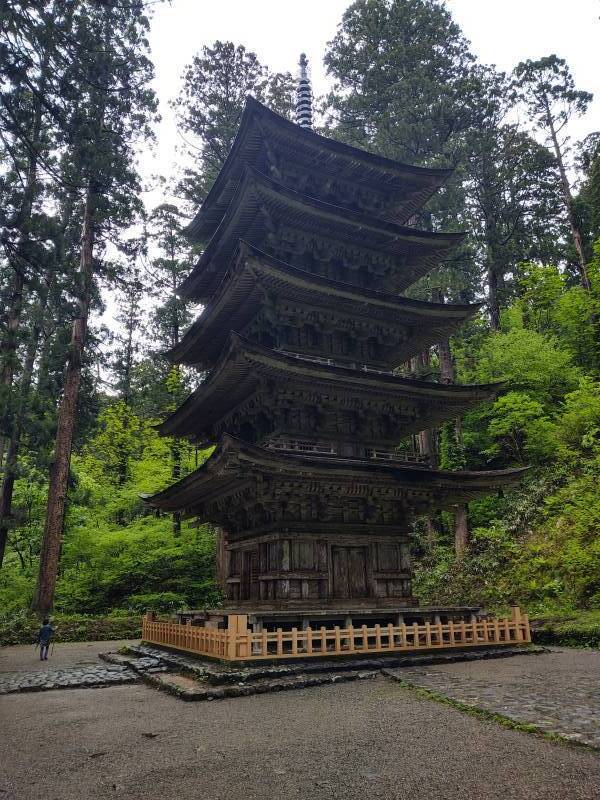
A Pause in Shugendō
Jump aheadto the fixtures!
Buddhism's foreign origin did not sit well with the growing nationalist feelings. For several centuries the Buddhist Shōguns had ruled Japan while the Emperor remained in Kyōto carrying out Shintō rituals.
In 1853, U.S. Navy Commodore Matthew Perry sailed his fleet into the bay of Edo, which at that time was a fishing village on a fantastic harbor bay. He demanded that the Shōgun open Japan's ports to U.S. commercial ships. Out-gunned, the Shōgun was forced to agree.
The Tokugawa Shōgunate soon collapsed, and in the 1868 Meiji Restoration, the Emperor Meiji took control and moved the Imperial Court to Edo, which was renamed Tōkyō and started growing.
Shinbutsu-shūgō had been the blending of Shintō and Buddhism. Shintō kami were interpreted as Buddhas or at least Bodhisattvas. Small Shintō shrines were added to Buddhist temple complexes, and Buddhist figures were placed at Shintō shrines.
Shinbutsu-bunri was their forcible separation, ordered by Emperor Meiji. It was meant to purify Shintō, and it led to a violent anti-Buddhist movement.
The violence lasted just a few years, and the ordered separation was never really successful. For example, Buddhism provided funeral services, whie Shintō really didn't. However, the forced separation did elevate Shintō and it led to much greater promotion of the belief that the Emperor was descended from the very first deities of Japanese cosmology, Kuninotokotachi and Amenominakanushi, who came into being on their own.1
The nationalist mindset really took off with the Emperor back in power and Shintō beating the drum about his status.
There was the First Sino-Japanese War of 1894–1895, in which Japan defeated China in a conflict over influence in Korea. There was the Russo-Japanese War of 1904–1905, over their ambitions in Manchuria and Korea. Japan also won that war, and annexed Korea in 1910. Then Japan invaded Manchuria in 1931 and established the puppet state of Manchukuo. And then the Second Sino-Japanese War of 1937–1945, leading into and lasting through World War II.
After the conclusion of World War II, the Emperor (named Hirohito at birth, always called "the Emperor" during his reign, and referred to as Shōwa afterward, at least in Japan) wrote a statement to satisfy the Allied demand that the Emperor could only remain in office if he renounced Shintō's claims of Imperial godhood. This is often referred to as "ending State Shintō", but there really never was anything called that in Japan.
The Emperor issued what has sometimes been called the Humanity Declaration on New Year's Day, 1946. In it, he said that he was not an Akitsumikami, a deity in human form, and that he was not descended from the sun goddess Amaterasu and her brother the storm god Susano-o. The statement also said that the stories of the creation of Japan as described in the early 8th century Kojiki and Nihon Shoki were myth, not history.
Or at least that was the Western interpretation. The statement was written in archaic and formal Japanese. It was so archaic and formal that most people in Japan couldn't make sense of it. However, the official English translation included a passage near its end that satisfied General Douglas MacArthur, the Supreme Commander of the Allied Forces, and that was enough. The Second Sino-Japanese War had started in 1937, it was time to move on.
Debate continues over the precise meaning of some unusual phrases, but it's clear that Emperor Hirohito did not really renounce the idea that the Emperor should be considered as a descendant of the gods.
In December 1945, the month before the Humanity Declaration, Hirohito said, "It is permissible to say that the idea that the Japanese people are descendants of the gods is a false conception; but it is absolutely impermissible to call chimerical the idea that the Emperor is a descendant of the gods." Put simply, "You can say that the Japanese people aren't gods, but the Emperor certainly is." The Emperor, along with other critics of the U.S. interpretation, argued that the point of the statement was not to deny divinity.
From the Meiji Restoration in 1868 to the end of World War II in 1945, people in Japan could practice other religions as long as they practiced and believed the parts of Shintō about the Emperor's divinity, and as long as no parts of their other religions conflicted with that.
After 1945, the Emperor and anyone else who cared to do so could continue to believe that the Emperor was a god. Meanwhile, everyone else was guaranteed true freedom of religion. And so, Shugendō was allowed once again.
Dewa Sanzan
Jump aheadto the fixtures!
Dewa Sanzan are three mountains in the ancient province of Dewa — Mount Haguro, Mount Gassan, and Mount Yudono. They are holy mountains to Shugendō. Prince Hachiko established Mount Haguro as a religious center in 593 CE, and soon established shrines on the others. Shugendō specifics arrived later and adopted the local sites and traditions.
Hachiko was the first-born son of Emperor Sushun, the 32nd Emperor on the official list (thus great36-grandson of Amaterasu). Sushun's father, Emperor Kinmei, is often regarded as the first historically verifiable Japanese Emperor.
The mountains remain popular pilgrimage sites today. Gassan and Yudono are higher, and are only open from late spring through early fall. Mount Haguro enshrines deities of all three at its peak, and it's accessible by car and bus if you don't want to walk, so it gets a lot of visitors.
Emperor Sushun had ascended to the throne with the support of the Soga clan, and had married a daughter of the Soga chief. However, Sushun came to resent the power of the Soga clan chief. After enough insults, Soga no Umako, chief of the Soga clan, hired Yamatonoaya to assassinate the Emperor in 592.
Nara
Hachiko fled the Soga assassins in the Imperial capital at Heijō-kyō, today's Nara, and arrived far to the north in Dewa province in 593. There was no way Hachiko could become Emperor, so he dedicated his life to religious pursuits. He underwent a period of penances, and then difficult ascetic exercises, and came to worship Haguro Gongen, the deity for which the mountain is named.
Then he expanded his worship to the nearby higher peaks of Gassan and Yudono. Given the relative difficulty of climbing those other two summits, the shrine complex on Haguro was expanded to — as Shintō puts it — enshrine the deities of all three peaks.
Let's make the trek up Mount Haguro. It's 2,446 stone steps to reach the peak at an elevation of 414 meters. You start with a short descent to a stream at 140 meters, pictured above with the two small shrines by the waterfall. So, you're climbing 274 meters while covering 1.7 kilometers along the trail.
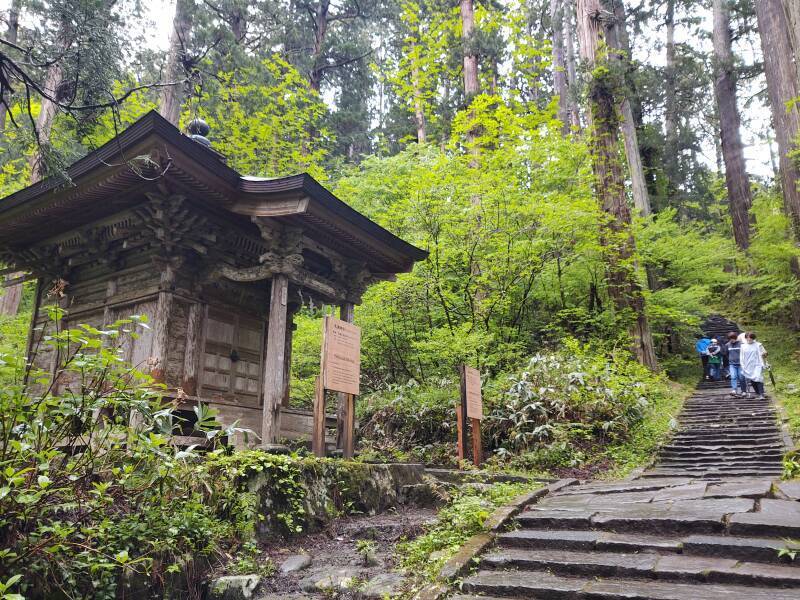
You pass over 400 Japanese cedar trees ranging from 350 to 600 years in age.
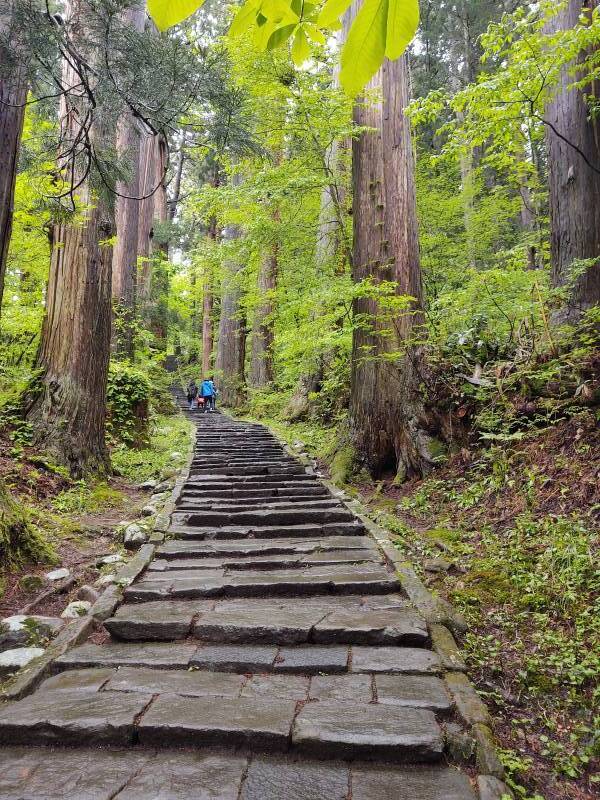
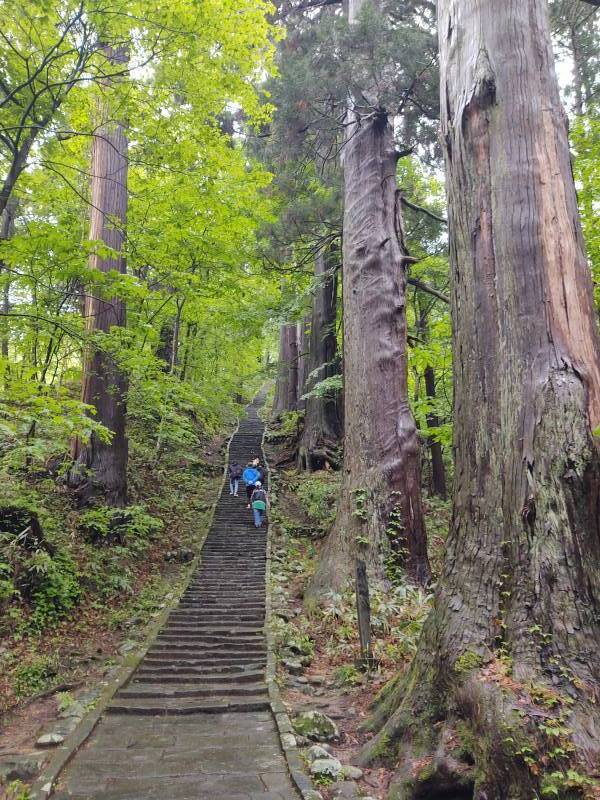
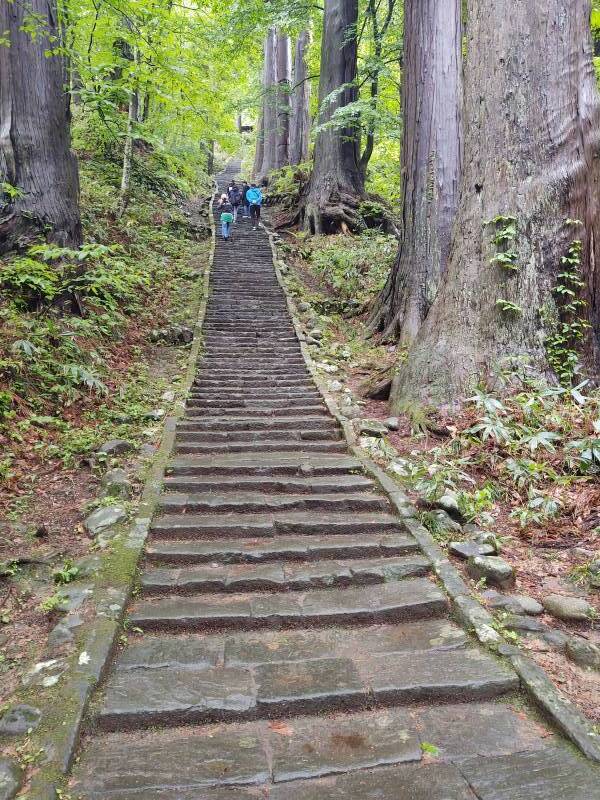
Off to the side of the trail, there's a site where a temple named Shionji was built by the yamabushi Tenyu-hoin.
In the second year of the Genroku era, so in 1690 CE, the famous poet Bashō composed a haiku here.
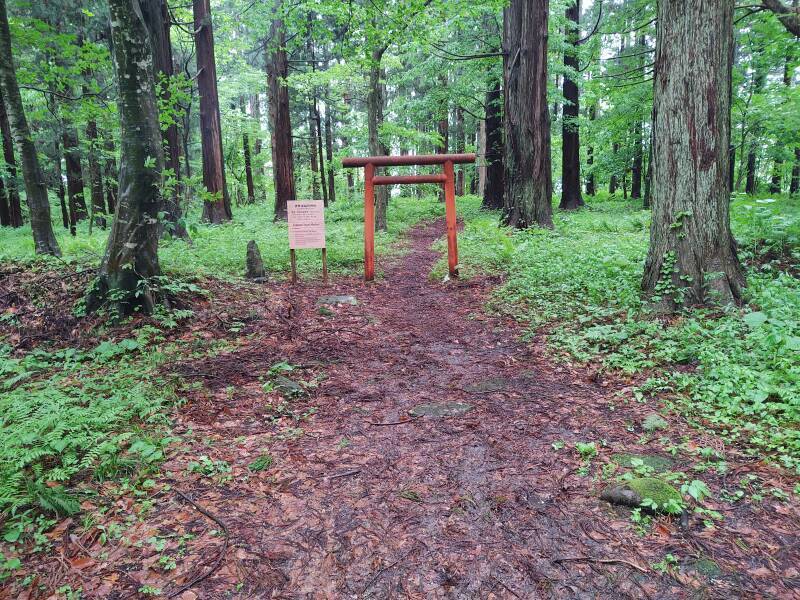
This is not Bashō's haiku:
Who would write a limerick haiku.
But
On we go. The trail includes the First Slope, Second Slope, and Third Slope, steep stretches with gently sloping areas between them.
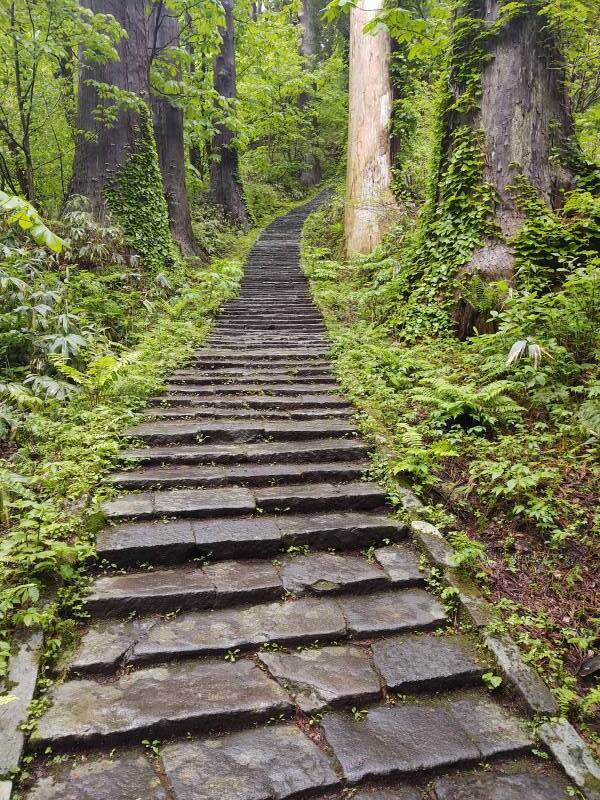
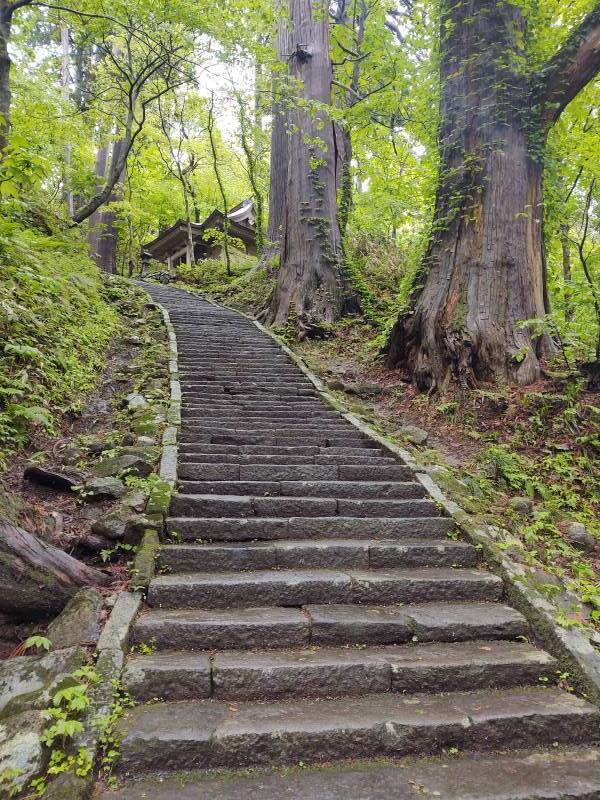
Finally Reaching the Top
Jump aheadto the fixtures!
A large vermillion torii marks the top of the trail. Just before reaching this, you pass a shrine, dormitory, and study area used by monks in training. From the Meiji Restoration through World War II, 1868–1945, all training here was Shintō training. Now it's back to Shugendō.
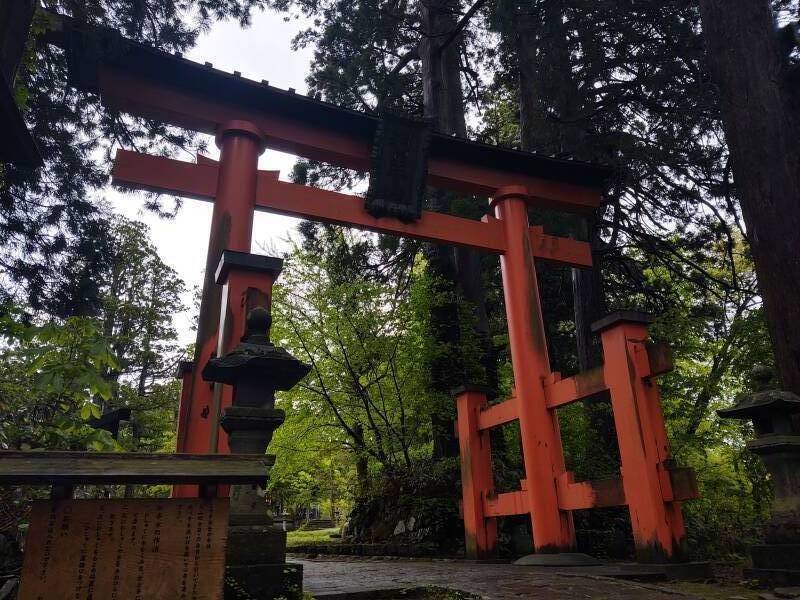
The Yamabushi or Shungenja can once again undergo training here. However, it isn't necessarily as arduous as it was back in the day. Aki no Mine is training said to carry out the original form of training, including "staying in the mountain for about a week", beginning on August 25th each year. Now, does that mean sleeping rough in the forest? Or staying at the dormitory at the summit complex? I don't know.
Similarly, Fuyu no Mine "refers to the training staying in the mountain for 100 days", ending on New Year's Eve.
I had picked up a nice fold-out brochure at the tourist office across from the train station in Tsuruoka. It included a map of Mount Haguro and the town at its base where I would be staying. All but two of the 28 guesthouses on that map are indicated as shukubo, or lodging for mountain priests. So, some stay down there and walk up every day.
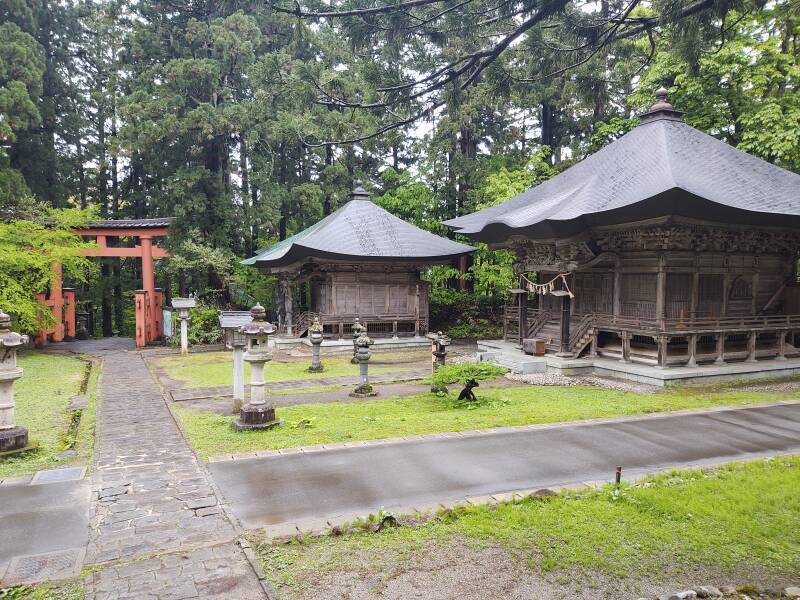
But of course you're wondering, "What sort of water fixtures did you encounter at these Shugendō sites?"
The Sanzan Gosai-den, the main temple/shrine at the summit, begins the plumbing details. Here it is. Notice the water cannon to the left.
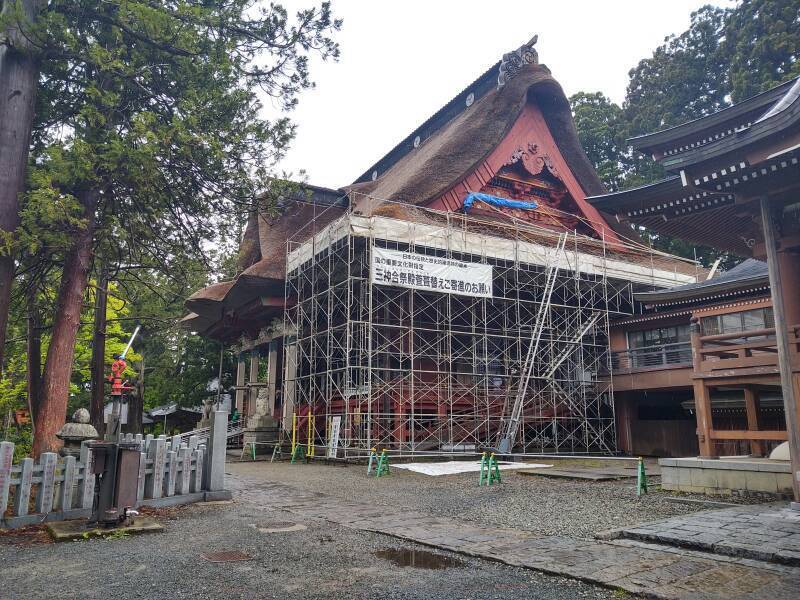
This is Japan's largest shrine with a thatched straw roof. It's made of local cedar trees, with the inside of the structure lacquered. It's a highly flammable structure. Plus, candles and incense are constantly burned inside. And, it's the tallest structure on a mountaintop, so it's a prime target for lightning.
The multiple prepositioned water cannons around the shrine complex are an excellent idea.
Gosai-den makes that a Buddhist name for a temple. Literally, the "three-god-combined temple". That's how it was shown on the map from the tourist office.
Google Maps labels it as the Dewasanzan-jinja Shrine, making it a Shintō name for a shrine. Google also adds "shrine" to the label.
The multiple names are confusing.
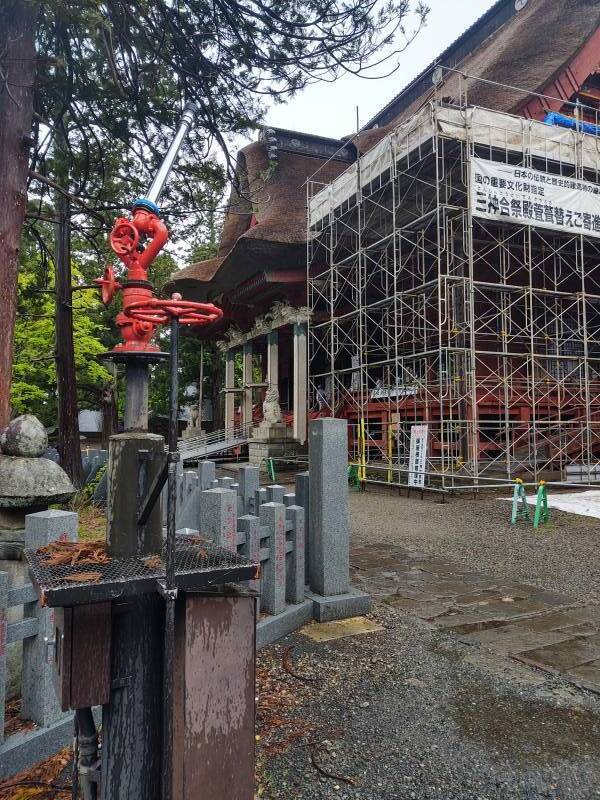
There was no large rope hanging down in the middle of the entryway, which you could shake to sound some rattles. The rope and rattles would be a Shintō thing, used along with a double hand clap to awaken the Shintō kami. Nor are there white paper zigzags or heavy knotted straw ropes, other Shintō features.
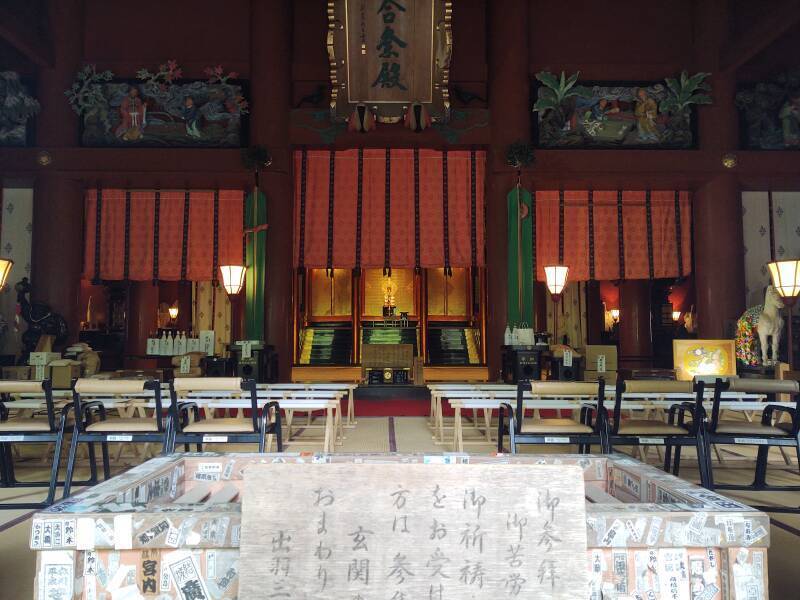
Inside, there is no Buddha or Bodhisattva statue. But neither are there what seem to me to be overt Shintō symbols. The object at the center front isn't a statue, but it also isn't what I would expect of the usual Shintō symbol of the invisible enshrined kami, typically a mirror. And so, I chose to interpret this as a cautiously non-committal temple-slash-shrine. Probably for several decades after 1945 it would have continued to look predominantly Shintō.
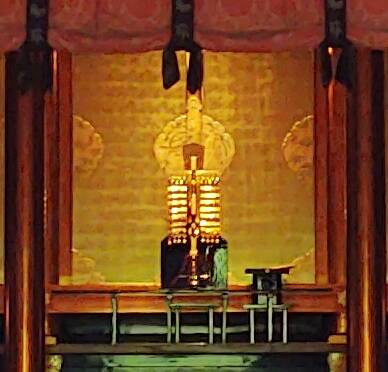
Back to the water fixtures! This is a chozu-bachi, a washbasin used for ritual purification. Ten'yū the 50th Bettō, or chief monk performing Buddhist rites, built this around the time the nearby Tōshōū shrine was built in 1643. This was early in the Edo period, during the Tokugawa Shōgunate. This is when the monks built the first stone steps up the trail.
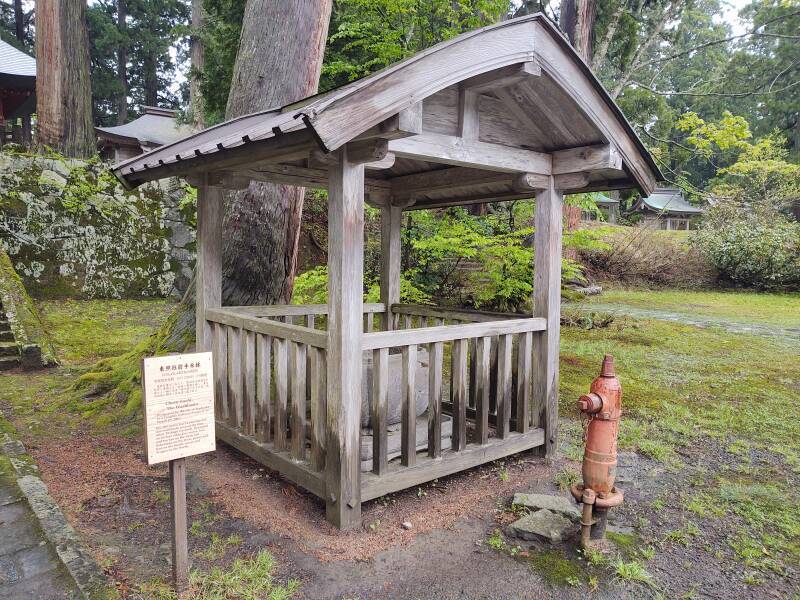
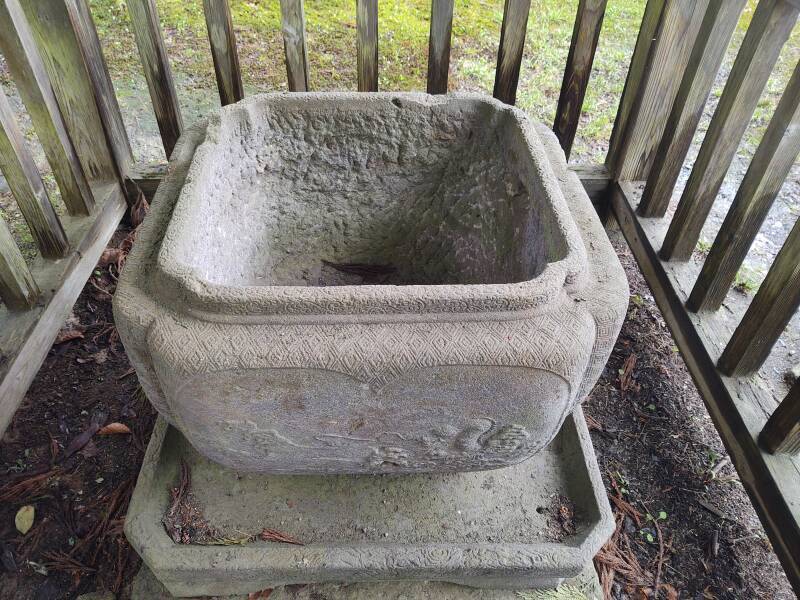
It is decorated on its east side with waves, koi, and tennyo, female spiritual beings like angels. Tennyo are usually depicted as beautiful women wearing colorful kimonos and flowing scarves wrapped loosely around their bodies, carrying lotus blossoms as a symbol of enlightenment or playing musical instruments.
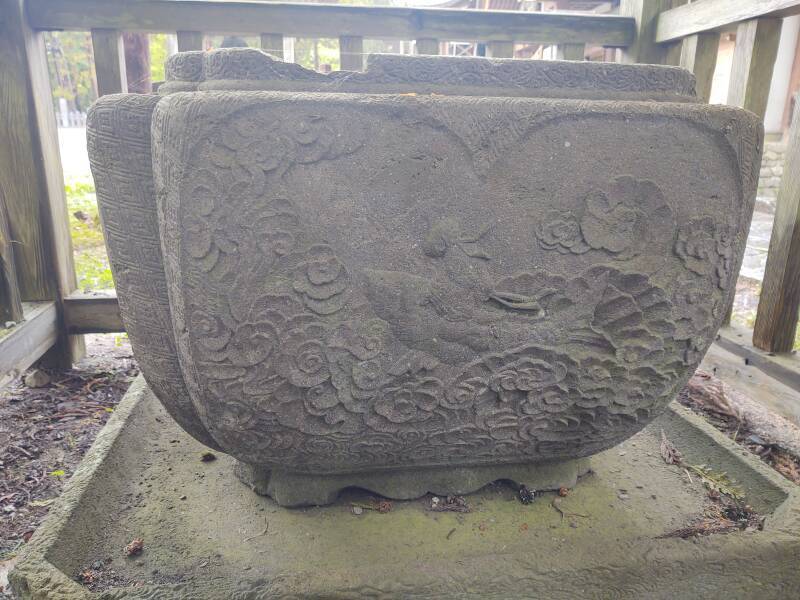
The south side has peonies and a lion:
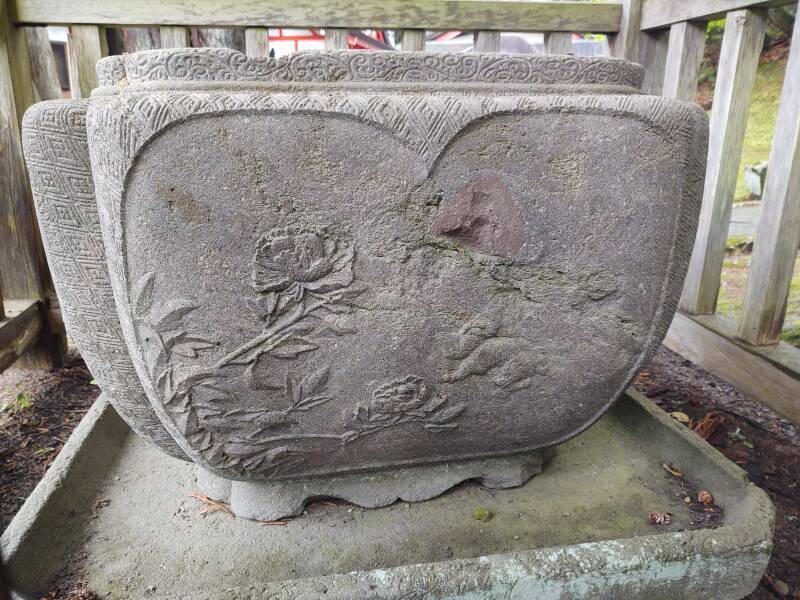
The west side has old fishermen:
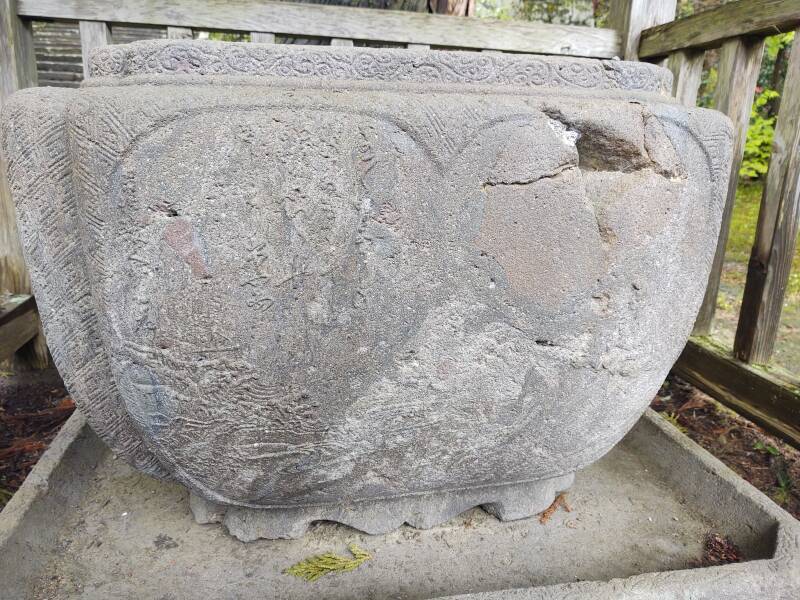
And, the north side has a dragon above a seascape:
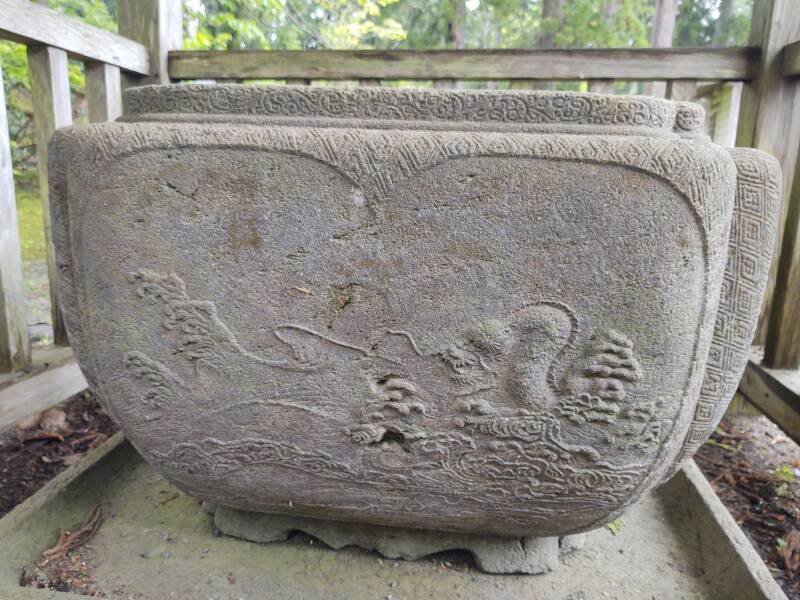
There's now a road leading up the other side of the mountain. People can drive there, and even take a city bus from Tsuruoka.
I had visited Japan in 2017 and 2018, and learned about the ablutions ritual used at both Buddhist temples and Shintō shrines. So, I was surprised when I returned in 2023 to discover that the large ablutions washbasin near the entrance for people arriving by vehicle had been closed down due to COVID.
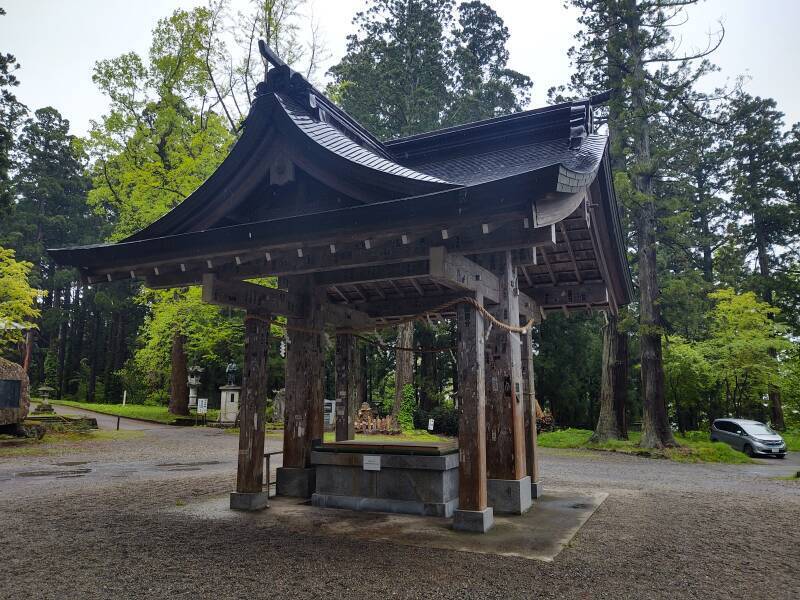
At all the other shrines I had visited by this point in my 2023 trip, I had noticed that while the washbasin might still have water running into it, the wooden and metal dippers had been removed. This struck me as a huge change, as people in Japan could no longer clean themselves properly before approaching religious facilities.
Below is the Reisaiden, the Building of Enshrined Spirits. It's a recently added structure of more (but not entirely) Buddhist design, decoration, and use. Buddhism has traditionally provided the funeral services for the Japanese people. A nearby sign explains:
The mountain enshrines spirits of departed dead as a site for peace and tranquility of ancestral spirits. A painting on the ceiling "Ten'nyo to Ryū" (The Heavenly Maidens and The Dragons) is a piece by Fujio Kumazawa. The celestial world where those heavenly maidens live is believed to be the world where one can obtain longevity of 8,000 years, and the painting holds the wish for the ancestral spirits to ascend to this world, which is protected by the Dragon deities.
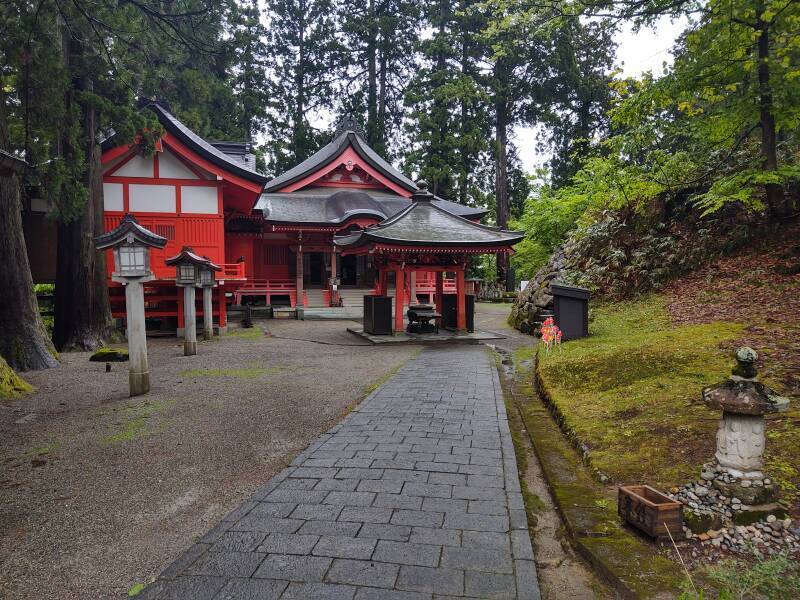
Modern Toilets for Today's Pilgrims
So what about the modern visitor to this Shugendō religious complex? Public facilities are available.
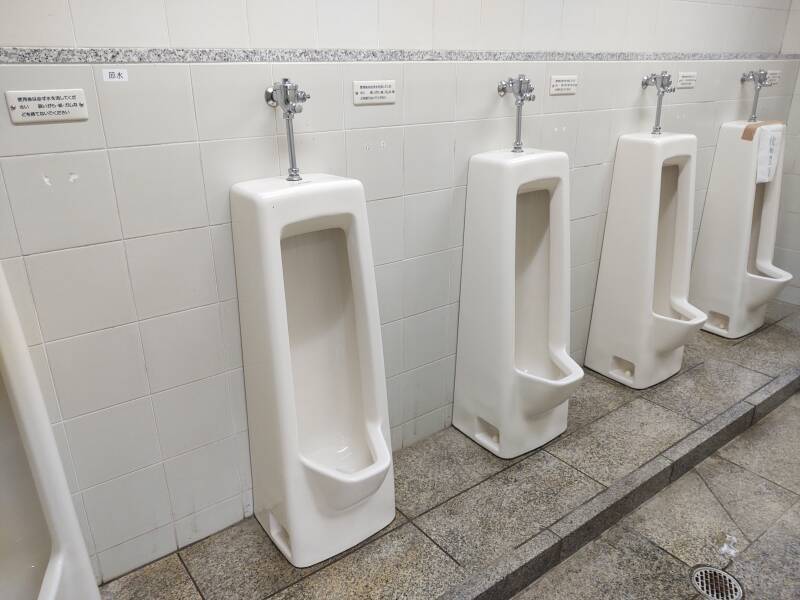
The controls for this water spray aren't as conveniently located as they usually are.
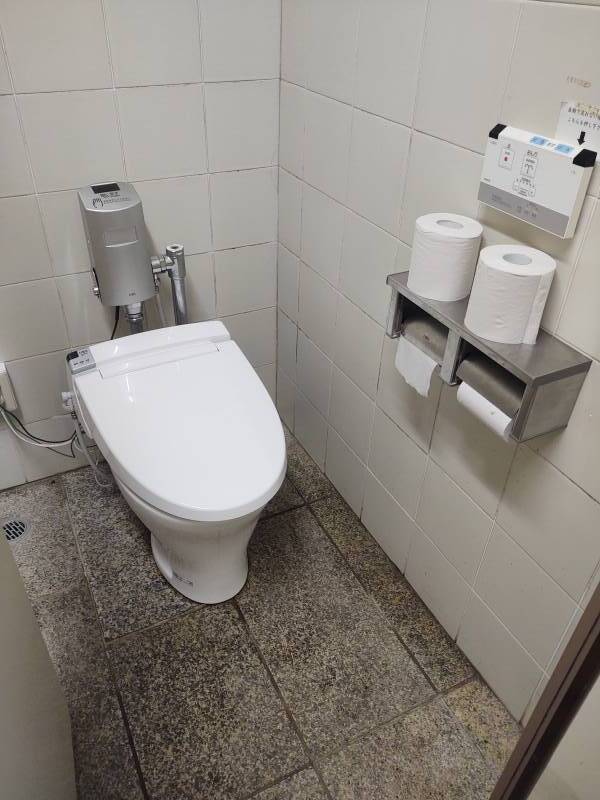
Cleaning Up After the Climb
The climb back down isn't easy. It's tough on your knees and quadriceps, and you really notice how narrow the steps are.
I was tired and felt like I might be sore the next day. It was time for a shower and a hot soak in the tub at my guesthouse!
Guesthouses at Booking.comI stayed at the Tamonkan guesthouse, where my traditional room along with breakfast and dinner was just ¥ 8,800 or about US$ 66 per night. It has what I thought was a very nice bath. Of course you first use the shower to get completely clean.
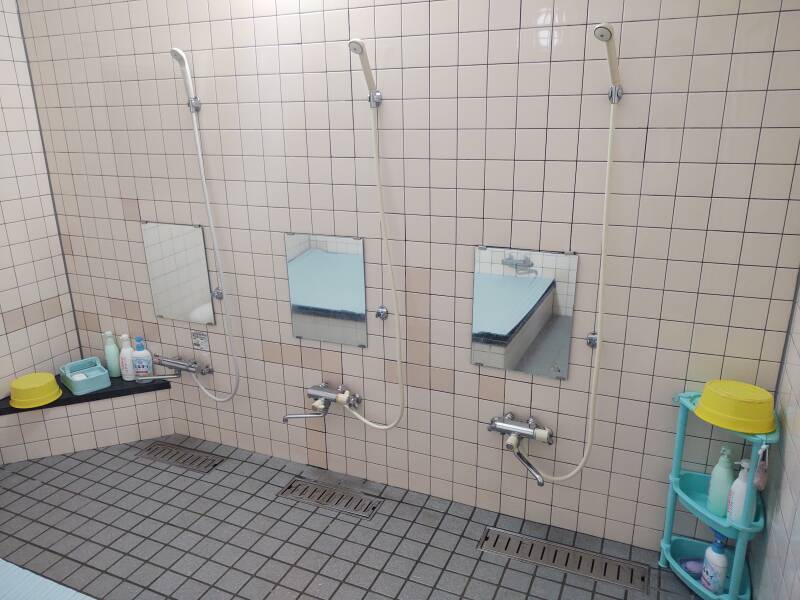
Stools let you sit down for your shower.
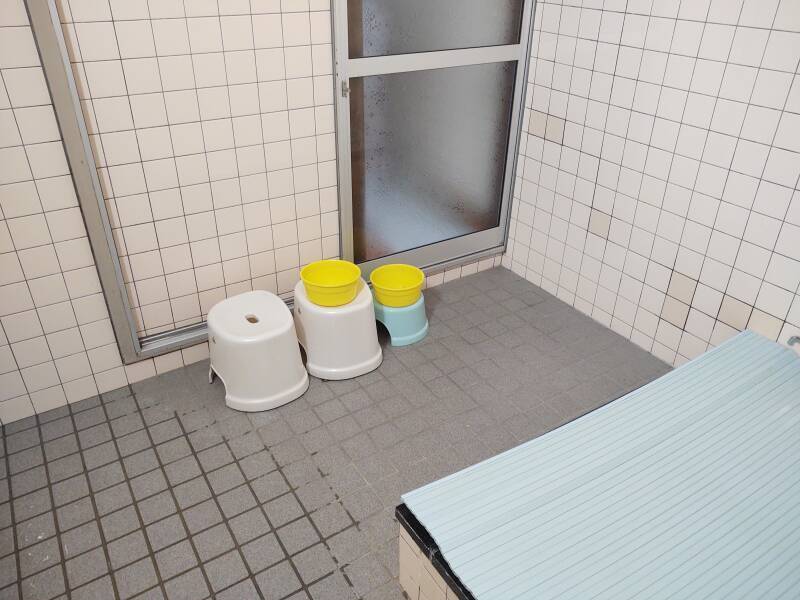
Then into the tub. It's quite warm, get in slowly. It's shoulder-deep, about a meter and a half by two meters in width and length.
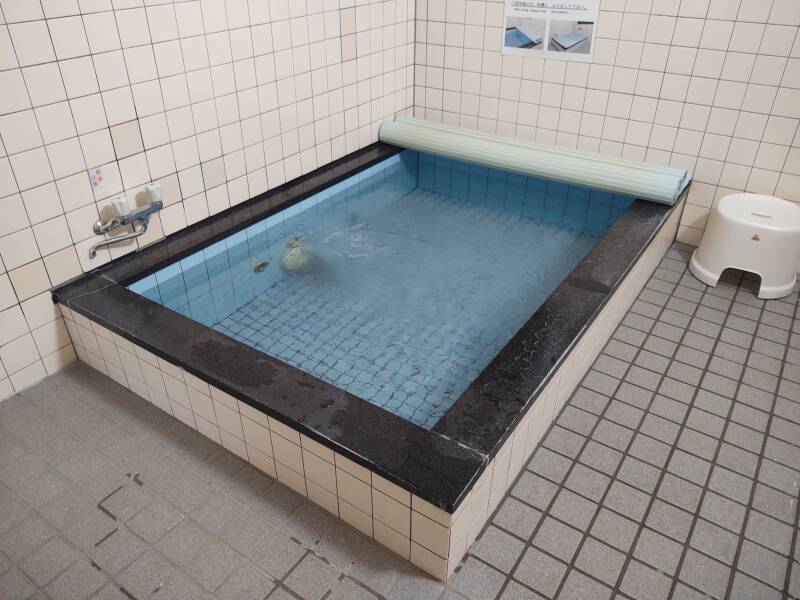
About the Meiji Restoration and Shinbutsu-bunri
The town at the base of the trail gets spelled both Toge and Touge in Romanji, the system for spelling Japanese words in Roman characters. I suppose that means it's either とーげ or とうげ to use Hiragana, used to phonetically spell Japanese words. Maps showing it in Japanese used Kanji, so I was totally lost with that. Anyway, "The town at the base of the path up Mount Haguro" is what I'm going on about here.
The town has been the home of guesthouses for visiting monks and pilgrims for centuries. There were 336 inns before the Meiji Restoration, now just 28 appear on the map.
The Shozen-in Koganedo is the primary Buddhist temple in town. I went there on my second day, after having trekked up Mount Haguro on my first day. Here's a view of it through the outer mon or gate.
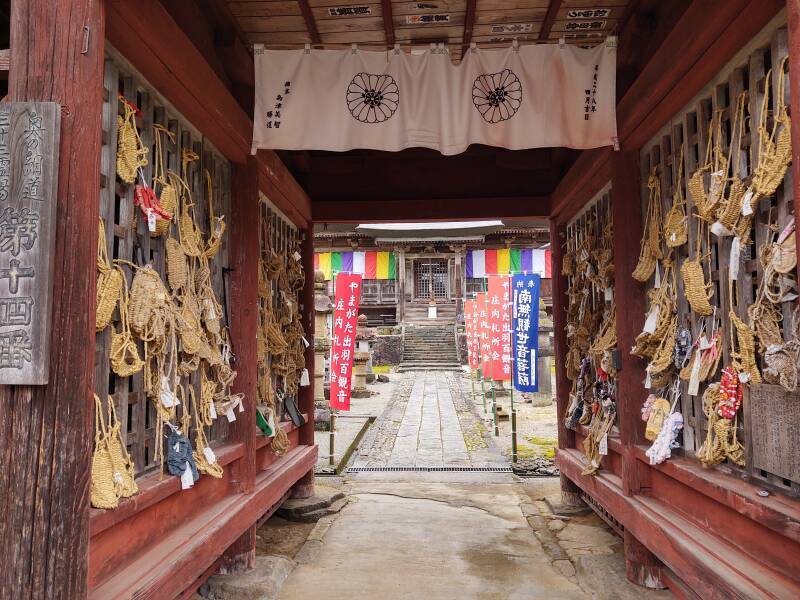
I walked around the temple grounds looking at the statues and monuments. I could see lighted candles inside. Up on the steps to the porch, I could hear voices. There were three pairs of shoes below the last steps up to the doors, so I decided that I would try, as politely as I could, to enter.
Three older women, the owners of those shoes, were inside. They had been sitting on small stools and talking and laughing with the priest. There was a lot of どうぞ, どうぞ, or dōzo, dōzo, "please, please" and gesturing for me to enter. They went bustling out with an air of "We were just leaving anyway".
The priest was delighted to have a foreign visitor, although he knew only a few words of English. However, he had an app on his phone that he could speak a phrase into and it would display the English translation. Through it, he explained that the temple was dedicated to Kannon, and it was known for having 33 Kannon statues — 15 to the left, 15 to the right, and a larger 3 at center, filling the front of the sanctuary.
This is the Bodhisattva of compassion, known as
अवलोकितेश्वर
or Avalokiteśvara in Sanskrit.
In China she was known as Guanyin,
which became Kannon in Japanese.
I asked, "Ah, Avalokiteśvara?",
and he got his phone to show me
"OLD NAME".
And he lit up, because he had an interested visitor
who wasn't utterly clueless.
He sent me around the "CIRCUIT",
a passage that goes around the central sanctuary,
almost a tunnel between the sanctuary and the exterior walls,
with a series of Buddha and Bodhisattva statues.
When I returned to my guesthouse,
my innkeeper was quite impressed that I had done that,
as it's considered equivalent to having visited
all three of the holy mountains
because of the Buddha images you see
on the three sides of the sanctuary,
one side per mountain.
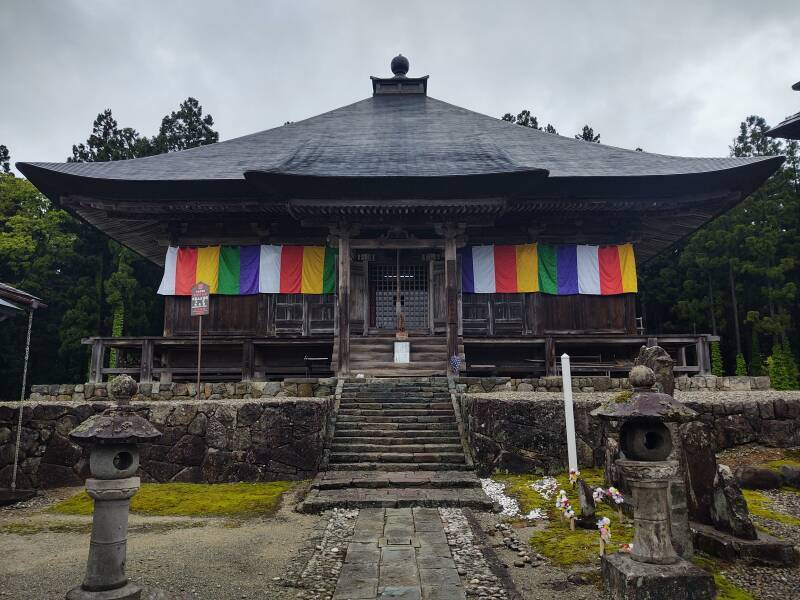
Then the priest started telling me some things through the phone translation that made me wonder if he was really telling me what I thought he was. Then it became clear that, yes, he was.
He is understandably not at all a fan of Emperor Meiji.
"NO RELIGION, ONLY WAR".
I must stress that he brought this up, not me.
I was totally into the belabored explanation of the Bodhisattvas
and was disoriented by the "But then this happened"
sudden turn.
Then there were some things about how Buddhism is supposed to be equal today, but is still disadvantaged relative to Shintō.
And then he got into how frustrating it is that the Japanese
people in general don't understand any of this,
they're all confused and think that
Buddhism and Shintō are basically the same thing.
Then,
"FOREIGNERS KNOW MORE THAN JAPANESE PEOPLE KNOW
ABOUT JAPANESE RELIGION".
I'm a visitor to his country, and so I've tried to understand
what I'm looking at,
and what's going on,
and what I should do in certain situations.
And then I get confused by what I see others doing.
I tried to tell him about how I had often noticed local people
walking up to the entry to a Buddhist temple
and then doing the very Shintō-specific double clap.
"YES YES EXACTLY".
And so that was certainly an interesting temple visit!
Then I wanted to continue wandering around town. But it would be good to visit the bathroom before continuing.
Ah, right there on the edge of the temple grounds was a public bathroom!
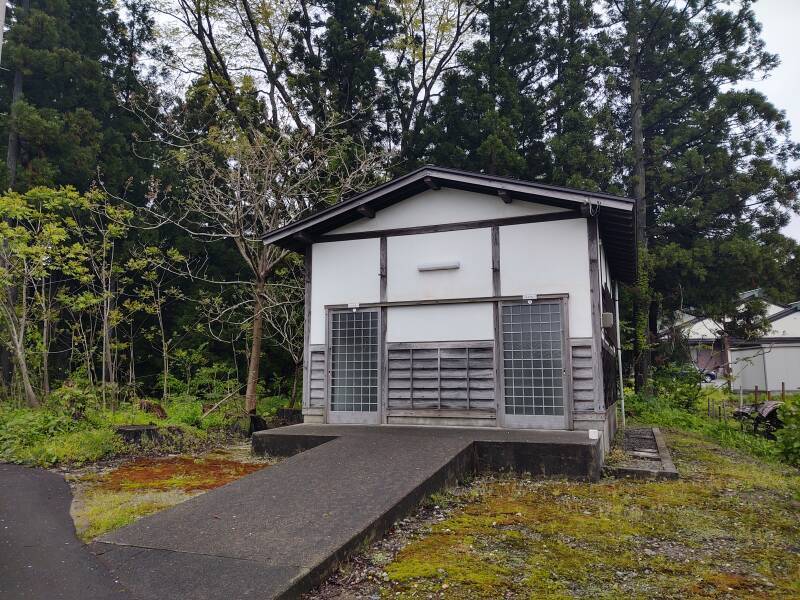
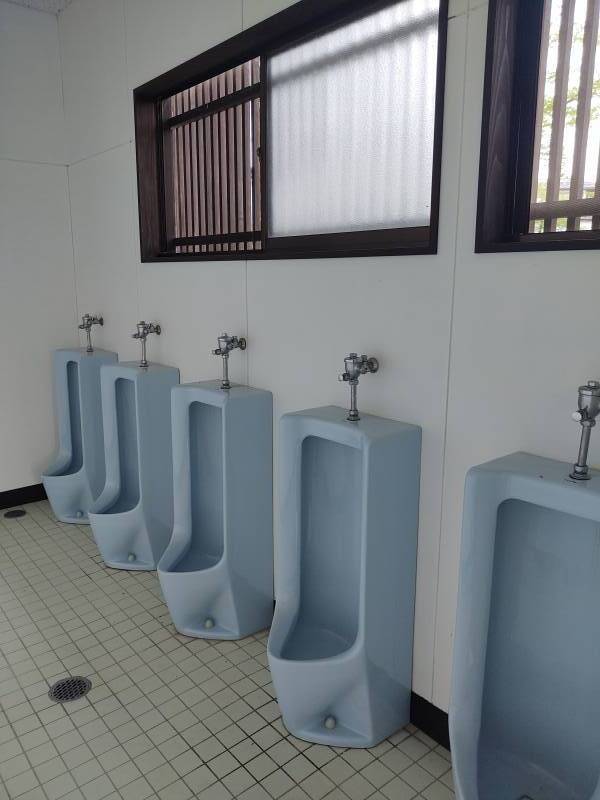
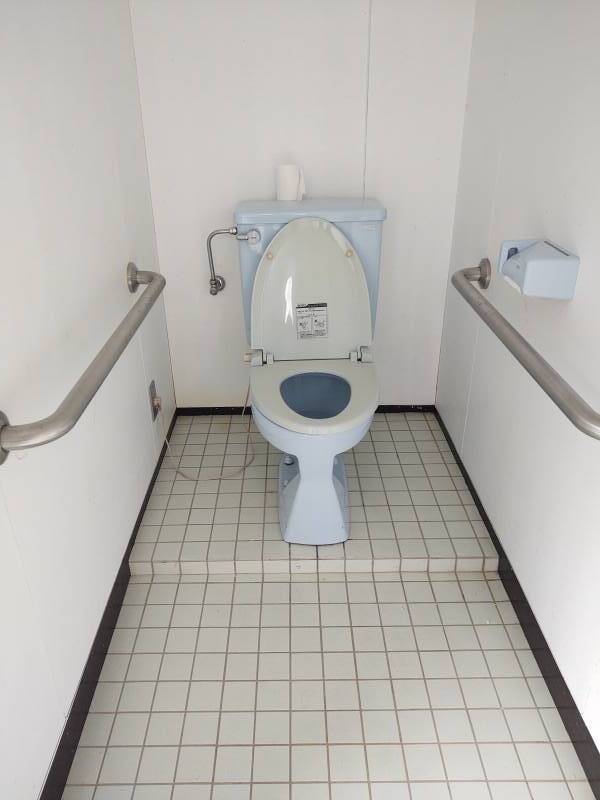
It's a public toilet with a heated seat and water spray. There's a dry spare roll of toilet paper. Everything is clean and working. Well, of course, this is Japan.
A Sani-Flush blue border indicates a toilet, sink, shower, or other plumbing that I've used.
The Toilet Guru's travel suggestions
Now some lurid advertisements from Google AdSense:
 To the Main Page
To the Main Page
1: Those two created Izanagi and Izanami, who were brother and sister and also husband and wife. They in turn gave birth to many of the kami. Izanami died after giving birth to the fire-god Kagu-tsuchi. Izanagi killed the fire-god and then gave birth to Ameterasu, the sun goddess, from his left eye; Tsukuyomi, the moon god, from his right eye, and Susano-o no Mikoto, the storm god, from his nose.
Amaterasu is the goddess of the sun and the entire universe. She gave the Sacred Mirror, the Sacred Sword, and the Sacred Jewel to her grandson. They're the three pieces of the regalia of the Emperor, supposedly still in existence. They're only seen by certain priests and the Emperor during the enthronement ceremony, and otherwise remain hidden at the Grand Shrine in Ise, the Atsuta Shrine in Nagoya, and the Imperial Palace in Tōkyō, respectively. Amaterasu's grandson then gave them to his great-grandson, Jimmu, who became the first Emperor of Japan.